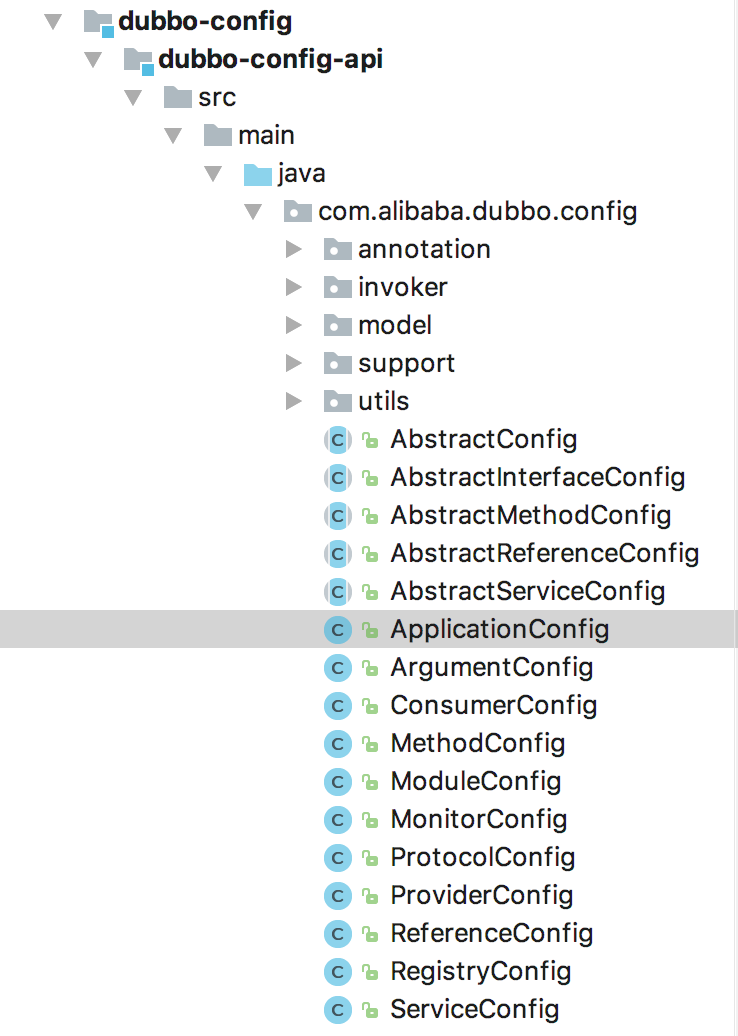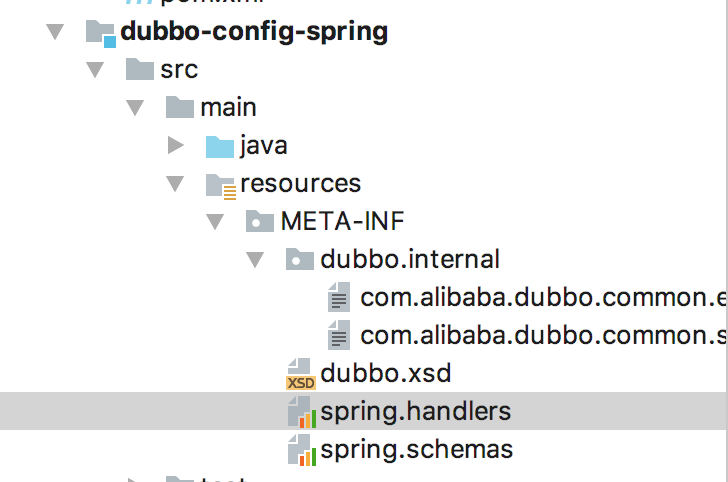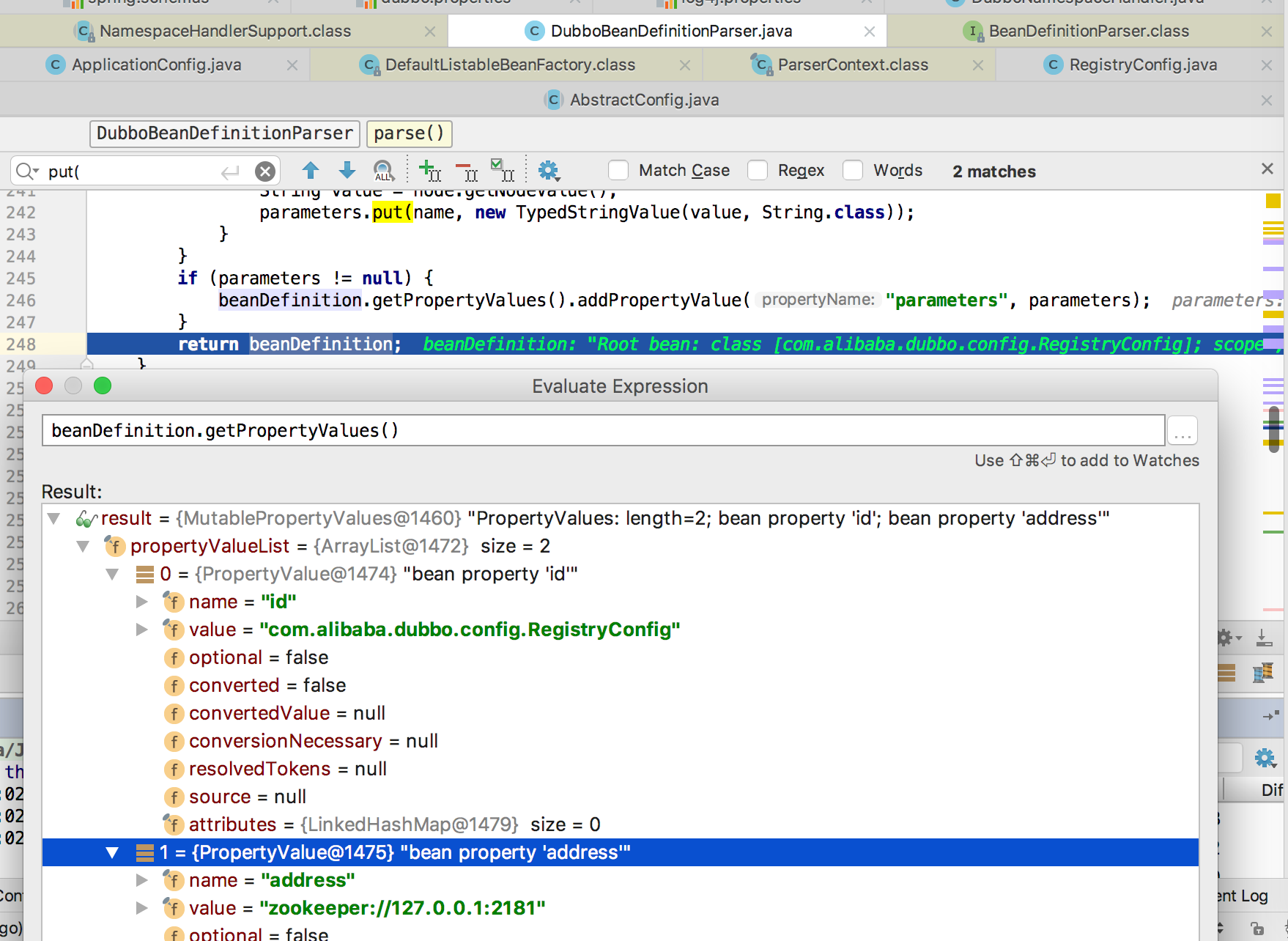Dubbo源码-Dubbo是如何随心所欲自定义XML标签的
叨叨
今天考虑了很久要不要写这篇文章。
距离《Dubbo源码》系列的开篇到现在已经快两个月时间了。当时是想着工作上的RPC框架使用存在一些让人头疼的问题,就来看看Dubbo给出了一套什么样的解决方案。
结果,写完第一篇没几天,工作上因为要赶一个项目的进度,关小黑屋了,前段时间刚放出来-_-!
琢磨着,做事不能半途而废。今天就又打开了Dubbo项目,pull下代码,在十多个子模块之间来回滚动,感觉都不是好惹的,一时不知道从哪下手了。再一想,Dubbo源码系列不能就这么唐突的出一篇就结束了啊。
行,思来想去,还是接着从上篇提到的dubbo-demo模块继续往下说……
正文
下面是dubbo-demo-provider模块下的dubbo-demo-provider.xml配置文件内容
<?xml version="1.0" encoding="UTF-8"?>
<!--
Licensed to the Apache Software Foundation (ASF) under one or more
contributor license agreements. See the NOTICE file distributed with
this work for additional information regarding copyright ownership.
The ASF licenses this file to You under the Apache License, Version 2.0
(the "License"); you may not use this file except in compliance with
the License. You may obtain a copy of the License at
http://www.apache.org/licenses/LICENSE-2.0
Unless required by applicable law or agreed to in writing, software
distributed under the License is distributed on an "AS IS" BASIS,
WITHOUT WARRANTIES OR CONDITIONS OF ANY KIND, either express or implied.
See the License for the specific language governing permissions and
limitations under the License.
-->
<beans xmlns:xsi="http://www.w3.org/2001/XMLSchema-instance"
xmlns:dubbo="http://dubbo.apache.org/schema/dubbo"
xmlns="http://www.springframework.org/schema/beans"
xsi:schemaLocation="http://www.springframework.org/schema/beans http://www.springframework.org/schema/beans/spring-beans-4.3.xsd
http://dubbo.apache.org/schema/dubbo http://dubbo.apache.org/schema/dubbo/dubbo.xsd">
<!-- provider's application name, used for tracing dependency relationship -->
<dubbo:application name="demo-provider"/>
<!-- use zookeeper registry center to export service -->
<dubbo:registry address="zookeeper://127.0.0.1:2181"/>
<!-- use dubbo protocol to export service on port 20880 -->
<dubbo:protocol name="dubbo" port="20880"/>
<!-- service implementation, as same as regular local bean -->
<bean id="demoService" class="com.alibaba.dubbo.demo.provider.DemoServiceImpl"/>
<!-- declare the service interface to be exported -->
<dubbo:service interface="com.alibaba.dubbo.demo.DemoService" ref="demoService"/>
</beans>
注意:这里的dubbo:registry在上篇已经说明,有过改动,这里使用的是zookeeper的配置
dubbo-demo-provider与常见的xml文件有何不同
1、除了<bean id="demoService" ... 其他的标签我们日常都没有使用过
我们平常使用的xml都是在Spring框架下,所以可以看到熟悉的、 、等。那有没有想过,为什么定义一个标签就是生命一个bean,就能够在Spring上下文注册一个类的实例呢?其实,这些工作Spring在幕后都帮我们做好了,这个我在之前的《Spring读书笔记》系列有着重写过。
稍稍扫一眼Dubbo的代码,就会发现,Dubbo也是基于Spring开发的,使用了Spring的很多特性,但是鉴于自己的业务框架需求,需要做相应的拓展和定制化,实现一套自己的自定义XML标签。那么这些标签又是如何生效和被使用的呢
基于Spring的Schema提供自定义配置支持
在dubbo-demo-provider.xml中见到的那些标签也是基于Spring的Schema实现的一套自定义标签。
这一套流程主要包括以下几个步骤:
编写配置类和属性
编写XSD文件
编写spring.handlers和spring.schemas
编写DubboNamespaceHandler和DubboBeanDefinitionParser,主要负责标签解析
编写配置类和属性
针对dubbo-demo-provider中的<dubbo:application name="demo-provider"/>来说,该标签对应的配置类在dubbo-config-api模块下的ApplicationConfig。
package com.alibaba.dubbo.config;
import com.alibaba.dubbo.common.Constants;
import com.alibaba.dubbo.common.compiler.support.AdaptiveCompiler;
import com.alibaba.dubbo.common.logger.LoggerFactory;
import com.alibaba.dubbo.config.support.Parameter;
import java.util.ArrayList;
import java.util.List;
import java.util.Map;
/**
* ApplicationConfig
*
* @export
*/
public class ApplicationConfig extends AbstractConfig {
private static final long serialVersionUID = 5508512956753757169L;
// application name
private String name;
// module version
private String version;
// application owner
private String owner;
// application's organization (BU)
private String organization;
// architecture layer
private String architecture;
// environment, e.g. dev, test or production
private String environment;
// Java compiler
private String compiler;
// logger
private String logger;
// registry centers
private List<RegistryConfig> registries;
// monitor center
private MonitorConfig monitor;
// is default or not
private Boolean isDefault;
// directory for saving thread dump
private String dumpDirectory;
private Boolean qosEnable;
private Integer qosPort;
private Boolean qosAcceptForeignIp;
// customized parameters
private Map<String, String> parameters;
public ApplicationConfig() {
}
public ApplicationConfig(String name) {
setName(name);
}
@Parameter(key = Constants.APPLICATION_KEY, required = true)
public String getName() {
return name;
}
public void setName(String name) {
checkName("name", name);
this.name = name;
if (id == null || id.length() == 0) {
id = name;
}
}
@Parameter(key = "application.version")
public String getVersion() {
return version;
}
public void setVersion(String version) {
this.version = version;
}
public String getOwner() {
return owner;
}
public void setOwner(String owner) {
checkMultiName("owner", owner);
this.owner = owner;
}
public String getOrganization() {
return organization;
}
public void setOrganization(String organization) {
checkName("organization", organization);
this.organization = organization;
}
public String getArchitecture() {
return architecture;
}
public void setArchitecture(String architecture) {
checkName("architecture", architecture);
this.architecture = architecture;
}
public String getEnvironment() {
return environment;
}
public void setEnvironment(String environment) {
checkName("environment", environment);
if (environment != null) {
if (!("develop".equals(environment) || "test".equals(environment) || "product".equals(environment))) {
throw new IllegalStateException("Unsupported environment: " + environment + ", only support develop/test/product, default is product.");
}
}
this.environment = environment;
}
public RegistryConfig getRegistry() {
return registries == null || registries.isEmpty() ? null : registries.get(0);
}
public void setRegistry(RegistryConfig registry) {
List<RegistryConfig> registries = new ArrayList<RegistryConfig>(1);
registries.add(registry);
this.registries = registries;
}
public List<RegistryConfig> getRegistries() {
return registries;
}
@SuppressWarnings({"unchecked"})
public void setRegistries(List<? extends RegistryConfig> registries) {
this.registries = (List<RegistryConfig>) registries;
}
public MonitorConfig getMonitor() {
return monitor;
}
public void setMonitor(MonitorConfig monitor) {
this.monitor = monitor;
}
public void setMonitor(String monitor) {
this.monitor = new MonitorConfig(monitor);
}
public String getCompiler() {
return compiler;
}
public void setCompiler(String compiler) {
this.compiler = compiler;
AdaptiveCompiler.setDefaultCompiler(compiler);
}
public String getLogger() {
return logger;
}
public void setLogger(String logger) {
this.logger = logger;
LoggerFactory.setLoggerAdapter(logger);
}
public Boolean isDefault() {
return isDefault;
}
public void setDefault(Boolean isDefault) {
this.isDefault = isDefault;
}
@Parameter(key = Constants.DUMP_DIRECTORY)
public String getDumpDirectory() {
return dumpDirectory;
}
public void setDumpDirectory(String dumpDirectory) {
this.dumpDirectory = dumpDirectory;
}
@Parameter(key = Constants.QOS_ENABLE)
public Boolean getQosEnable() {
return qosEnable;
}
public void setQosEnable(Boolean qosEnable) {
this.qosEnable = qosEnable;
}
@Parameter(key = Constants.QOS_PORT)
public Integer getQosPort() {
return qosPort;
}
public void setQosPort(Integer qosPort) {
this.qosPort = qosPort;
}
@Parameter(key = Constants.ACCEPT_FOREIGN_IP)
public Boolean getQosAcceptForeignIp() {
return qosAcceptForeignIp;
}
public void setQosAcceptForeignIp(Boolean qosAcceptForeignIp) {
this.qosAcceptForeignIp = qosAcceptForeignIp;
}
public Map<String, String> getParameters() {
return parameters;
}
public void setParameters(Map<String, String> parameters) {
checkParameterName(parameters);
this.parameters = parameters;
}
}
在ApplicationConfig同级目录下,还包括其他出现在dubbo-demo-provider.xml中出现自定义标签类,如RegistryConfig、ProtocolConfig

注意:<dubbo:application name="demo-provider"/>标签中的dubbo对应的声明在dubbo-demo-provider.xml中的xmlns:dubbo="http://dubbo.apache.org/schema/dubbo,这里的xmlns其实就是一个命名空间的概念。
编写XSD文件
XSD文件已经在dubbo-demo-provider文件中定义好了,dubbo.xsd在dubbo-config-spring模块下,内容较长,举Application为例
...
<xsd:element name="application" type="applicationType">
<xsd:annotation>
<xsd:documentation><![CDATA[ The application config ]]></xsd:documentation>
</xsd:annotation>
</xsd:element>
...
<xsd:complexType name="applicationType">
<xsd:sequence minOccurs="0" maxOccurs="unbounded">
<xsd:element ref="parameter" minOccurs="0" maxOccurs="unbounded"/>
</xsd:sequence>
<xsd:attribute name="id" type="xsd:ID">
<xsd:annotation>
<xsd:documentation><![CDATA[ The unique identifier for a bean. ]]></xsd:documentation>
</xsd:annotation>
</xsd:attribute>
<xsd:attribute name="name" type="xsd:string" use="required">
<xsd:annotation>
<xsd:documentation><![CDATA[ The application name. ]]></xsd:documentation>
</xsd:annotation>
</xsd:attribute>
<xsd:attribute name="version" type="xsd:string">
<xsd:annotation>
<xsd:documentation><![CDATA[ The application version. ]]></xsd:documentation>
</xsd:annotation>
</xsd:attribute>
<xsd:attribute name="owner" type="xsd:string">
<xsd:annotation>
<xsd:documentation><![CDATA[ The application owner name (email prefix). ]]></xsd:documentation>
</xsd:annotation>
</xsd:attribute>
<xsd:attribute name="organization" type="xsd:string">
<xsd:annotation>
<xsd:documentation><![CDATA[ The organization name. ]]></xsd:documentation>
</xsd:annotation>
</xsd:attribute>
<xsd:attribute name="architecture" type="xsd:string">
<xsd:annotation>
<xsd:documentation><![CDATA[ The architecture. ]]></xsd:documentation>
</xsd:annotation>
</xsd:attribute>
<xsd:attribute name="environment" type="xsd:string">
<xsd:annotation>
<xsd:documentation><![CDATA[ The application environment, eg: dev/test/run ]]></xsd:documentation>
</xsd:annotation>
</xsd:attribute>
<xsd:attribute name="compiler" type="xsd:string">
<xsd:annotation>
<xsd:documentation><![CDATA[ The java code compiler. ]]></xsd:documentation>
</xsd:annotation>
</xsd:attribute>
<xsd:attribute name="logger" type="xsd:string">
<xsd:annotation>
<xsd:documentation><![CDATA[ The application logger. ]]></xsd:documentation>
</xsd:annotation>
</xsd:attribute>
<xsd:attribute name="registry" type="xsd:string" use="optional">
<xsd:annotation>
<xsd:documentation><![CDATA[ The application registry. ]]></xsd:documentation>
</xsd:annotation>
</xsd:attribute>
<xsd:attribute name="monitor" type="xsd:string" use="optional">
<xsd:annotation>
<xsd:documentation><![CDATA[ The application monitor. ]]></xsd:documentation>
</xsd:annotation>
</xsd:attribute>
<xsd:attribute name="default" type="xsd:string" use="optional">
<xsd:annotation>
<xsd:documentation><![CDATA[ Is default. ]]></xsd:documentation>
</xsd:annotation>
</xsd:attribute>
</xsd:complexType>
...
代码中上面一部分代码<xsd:element name="application" type="applicationType">表示标签的名称
<xsd:attribute name="name" type="xsd:string" use="required">表示的是application标签的属性,与ApplicationConfig类的属性是一一对应的关系。这里表示有一个属性名为name,且是String类型,必填字段。
编写spring.handlers和spring.schemas
仅仅有上面的配置类和XSD文件还是无法让自定义标签工作,因为Spring还无法发现这些自定义标签,更别提让其发挥该有的作用了。
这时候,需要添加两个配置文件spring.handlers和spring.schemas,从文件字面意思就可以知道,这两个配置文件起到了贯通的作用。spring.handlers用于配置具体的解析类,下面会提到,spring.schemas用于指明schemas的文件路径。

我们可以在dubbo-config-spring模块中看到这两个配置文件
Spring会在启动容器的时候加载META-INF目录下的这两个配置文件并加载对应的解析类。
编写DubboNamespaceHandler和DubboBeanDefinitionParser,主要负责标签解析
DubboNamespaceHandler类位于dubbo-config-spring模块下
/*
* Licensed to the Apache Software Foundation (ASF) under one or more
* contributor license agreements. See the NOTICE file distributed with
* this work for additional information regarding copyright ownership.
* The ASF licenses this file to You under the Apache License, Version 2.0
* (the "License"); you may not use this file except in compliance with
* the License. You may obtain a copy of the License at
*
* http://www.apache.org/licenses/LICENSE-2.0
*
* Unless required by applicable law or agreed to in writing, software
* distributed under the License is distributed on an "AS IS" BASIS,
* WITHOUT WARRANTIES OR CONDITIONS OF ANY KIND, either express or implied.
* See the License for the specific language governing permissions and
* limitations under the License.
*/
package com.alibaba.dubbo.config.spring.schema;
import com.alibaba.dubbo.common.Version;
import com.alibaba.dubbo.config.ApplicationConfig;
import com.alibaba.dubbo.config.ConsumerConfig;
import com.alibaba.dubbo.config.ModuleConfig;
import com.alibaba.dubbo.config.MonitorConfig;
import com.alibaba.dubbo.config.ProtocolConfig;
import com.alibaba.dubbo.config.ProviderConfig;
import com.alibaba.dubbo.config.RegistryConfig;
import com.alibaba.dubbo.config.spring.ReferenceBean;
import com.alibaba.dubbo.config.spring.ServiceBean;
import org.springframework.beans.factory.xml.NamespaceHandlerSupport;
/**
* DubboNamespaceHandler
*
* @export
*/
public class DubboNamespaceHandler extends NamespaceHandlerSupport {
static {
Version.checkDuplicate(DubboNamespaceHandler.class);
}
@Override
public void init() {
registerBeanDefinitionParser("application", new DubboBeanDefinitionParser(ApplicationConfig.class, true));
registerBeanDefinitionParser("module", new DubboBeanDefinitionParser(ModuleConfig.class, true));
registerBeanDefinitionParser("registry", new DubboBeanDefinitionParser(RegistryConfig.class, true));
registerBeanDefinitionParser("monitor", new DubboBeanDefinitionParser(MonitorConfig.class, true));
registerBeanDefinitionParser("provider", new DubboBeanDefinitionParser(ProviderConfig.class, true));
registerBeanDefinitionParser("consumer", new DubboBeanDefinitionParser(ConsumerConfig.class, true));
registerBeanDefinitionParser("protocol", new DubboBeanDefinitionParser(ProtocolConfig.class, true));
registerBeanDefinitionParser("service", new DubboBeanDefinitionParser(ServiceBean.class, true));
registerBeanDefinitionParser("reference", new DubboBeanDefinitionParser(ReferenceBean.class, false));
registerBeanDefinitionParser("annotation", new AnnotationBeanDefinitionParser());
}
}
是不是又看到了之前在dubbo-demo-provider.xml配置文件中看到那些标签。没错,真正给那些标签赋能的功能代码就在这里。
具体的解析工作交给了dubbo-config-spring模块下的DubboBeanDefinitionParser类,该类实现了Spring的BeanDefinitionParser接口,该类的一个核心方法就是parse()方法,其抽丝剥茧解析标签,加载bean的思路其实和之前在《Spring读书笔记》系列中介绍的一样。最终都是解析并转化为BeanDefinition对象并塞到Spring的上下文中,完成Bean的加载。
我们可以以debug模式启动dubbo-demo-provider模块中的Provider类,通过打断点,会发现首先会执行DubboNamespaceHandler类中的init方法,然后进入DubboBeanDefinitionParser类中的parse方法。
配合dubbo-demo-provider.xml配置文件中的<dubbo:registry address="zookeeper://127.0.0.1:2181"/>,我们在调试的时候发现解析后对应的BeanDefinition如下

通过这样一个过程,就实现了将XML自定义的标签加载到Spring容器中,而不需要使用Spring自己的bean去定义。
明白了这个流程,后面看Dubbo的其他配置文件里面那些陌生的标签就不会蒙圈了。
如果您觉得阅读本文对您有帮助,请点一下“推荐”按钮,您的“推荐”将是我最大的写作动力!如果您想持续关注我的文章,请扫描二维码,关注JackieZheng的微信公众号,我会将我的文章推送给您,并和您一起分享我日常阅读过的优质文章。

Dubbo源码-Dubbo是如何随心所欲自定义XML标签的的更多相关文章
- Spring源码阅读笔记05:自定义xml标签解析
在上篇文章中,提到了在Spring中存在默认标签与自定义标签两种,并且详细分析了默认标签的解析,本文就来分析自定义标签的解析,像Spring中的AOP就是通过自定义标签来进行配置的,这里也是为后面学习 ...
- dubbo源码—dubbo自定义spring xml标签
dubbo为了和spring更好的集成,提供了一些xml配置标签,也就是自定义标签 spring自定义标签 spring自定义标签的方式如下: 设计配置属性和JavaBean 编写xsd文件,校验xm ...
- dubbo源码—dubbo简介
dubbo是一个RPC框架,应用方像使用本地service一样使用dubbo service.dubbo体系架构 上图中的角色: 最重要的是consumer.registry和provider con ...
- Spring源码阅读笔记04:默认xml标签解析
上文我们主要学习了Spring是如何获取xml配置文件并且将其转换成Document,我们知道xml文件是由各种标签组成,Spring需要将其解析成对应的配置信息.之前提到过Spring中的标签包括默 ...
- 6.2 dubbo在spring中自定义xml标签源码解析
在6.1 如何在spring中自定义xml标签中我们看到了在spring中自定义xml标签的方式.dubbo也是这样来实现的. 一 META_INF/dubbo.xsd 比较长,只列出<dubb ...
- Dubbo源码学习--服务发布(ServiceBean、ServiceConfig)
前面讲过Dubbo SPI拓展机制,通过ExtensionLoader实现可插拔加载拓展,本节将接着分析Dubbo的服务发布过程. 以源码中dubbo-demo模块作为切入口一步步走进Dubbo源码. ...
- dubbo源码解析五 --- 集群容错架构设计与原理分析
欢迎来我的 Star Followers 后期后继续更新Dubbo别的文章 Dubbo 源码分析系列之一环境搭建 博客园 Dubbo 入门之二 --- 项目结构解析 博客园 Dubbo 源码分析系列之 ...
- dubbo源码之服务发布与注册
服务端发布流程: dubbo 是基于 spring 配置来实现服务的发布的,对于dubbo 配置文件中看到的<dubbo:service>等标签都是服务发布的重要配置 ,对于这些提供可配置 ...
- dubbo源码分析(一)-从xml到我们认识的Java对象
项目中用的dubbo的挺多的,然后随着自己对dubbo的慢慢深入,自己也希望能够了解dubbo的底层实现,这半年来一直在看dubbo的源码,有点断断续续的,于是准备写一个dubbo源码系列的分析文章, ...
随机推荐
- Linux本地网络脚本配置(内网与外网)
脚本位于: /etc/sysconfig/network-scripts/ifcfg-eth0 DEVICE=eth0 //网卡的名字 BOOTPROTO=static // none静态IP ...
- Stackoverflow上人气最旺的10个Java问题
1. 为什么两个(1927年)时间相减得到一个奇怪的结果? (3623个赞) 如果执行下面的程序,程序解析两个间隔1秒的日期字符串并比较: 01 public static void main(Str ...
- Detours修改段属性漏洞
v:* { } o:* { } w:* { } .shape { }p.MsoNormal,li.MsoNormal,div.MsoNormal { margin: 0cm; margin-botto ...
- CMake命令行添加编译参数
CMake命令行添加编译参数 学习自 coroserver 例程: https://github.com/windoze/coroserver coroserver 是一个应用 Boost.Asio ...
- win7 64位系统,vs2010下配置OpenGL开发环境
glut下载地址: http://www.opengl.org/resources/libraries/glut/glutdlls37beta.zip 或者:http://user.xmission. ...
- java--字符编码,正则表达式
转载请申明出处:http://blog.csdn.net/xmxkf day21 字符编码 06-IO流(转换流的字符编码) 字符编码: 1. 字符流的出现为了方便操作字符,更重要的是加入了编码转 ...
- unix重定向标记
stdin ,0,< << stdout,1,> >> stderr,2,2> 2>> 将stdout和stderr输出到同一个文件: > ...
- Digogo ugdx文件的制作
The openplatform source code is in old IT FTP server at "vte/KCD/20150814/openplatform_wallace. ...
- mybatis中autoCommit自动提交事务
今天学习了下mybatis, 对其中的autoCommit自动提交事务比较好奇, 研究了下,把配置和代码都放上 mapper.xml如下: <?xml version="1.0&quo ...
- nifi1.6.0汉化
1.1 测试机 l Apache NiFi 1.6.0 l HDP 2.6.3 l 集群规模:单节点 l 操作系统:CentOs7 l 以下所有操作均在root用户下执行 1.2 安装环境 ...
